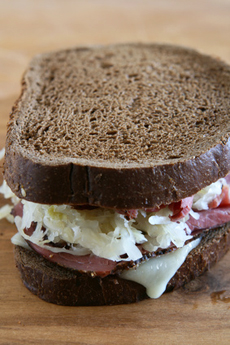
If you’re thinking of serving a high-cholesterol cheese fondue, contemplate a veggie stir-fry instead (photo © iGourmet).
|
|
Cheese, ice cream, beef, butter, mayonnaise—just a few of our staple foods that are high in cholesterol. According to the National Institutes For Health (NIH), the foods that make one’s bad cholesterol rise (the LDL, low density lipoprotein) are saturated fats which largely come from animals. With our national wealth and ability to buy all the meat we want, plus bad dietary habits (fast food, saturated fats, mayo and butter with everything), Americans have one of the worst diets in the world. Our challenge: eat well, decrease the foods that have raise bad cholesterol levels and eat foods that raise good cholesterol.
September is National Cholesterol Education Month: Heart disease is our number one killer. The NIH counts more than 65 million Americans who have high cholesterol. In addition to adopting a regular exercise routine (ouch!), it may be less painful to switch to the right foods. This benefits everyone in the household: adults who are closer to developing health problems and younger folks who can learn early how to avoid them. What you need to do isn’t so painful—in fact, it’s quite tasty. Every day, consider: |
- Fiber. The key is to get plenty of fiber, which can be found in whole grains, cereals, breads and pastas, fruits and vegetables. Chose whole fruit, which contains fiber, rather than drinking juice.
- Fruits and vegetables. Add a variety of fruits and vegetables to your daily menu, serving a side of fruit with each meal. A smoothie is a better snack than ice cream or frozen yogurt. Include mushrooms, garlic and onion in your recipes: They have properties that are known to lower cholesterol.
- Beans. Beans and legumes (like lentils) are fiber- and nutrient-rich. You can easily find ways to add kidney, pinto or other beans to casseroles, soups and salads. They also make beautiful sides; see our Bean & Grains Glossary for ideas.
- Nuts. Make one of your daily snacks raw or roasted nuts. Nuts are a heart-healthy food. In In 2003, the FDA approved the following claim for seven different types of nuts (almonds, hazelnuts, peanuts, pecans, pine nuts, pistachios and walnuts): “Scientific evidence suggests but does not prove that eating 1.5 oz per day of most nuts as part of a diet low in saturated fat and cholesterol may reduce the risk of heart disease.” Walnuts are perhaps the best: Compared to other nuts, they have a significantly higher amount of alpha linolenic acid, a type of plant-derived omega 3 fatty acid, similar to that found in salmon, which many studies show lowers total cholesterol and LDL cholesterol levels.” Almonds are a “second place” choice.
- Omega-3 Fatty Acids. Work fatty fish such as salmon, tuna and halibut into your meal plan, cook with canola oil and add tasty ground or whole flaxseed to recipes. Flaxseed can easily be added to cereal, soup, casseroles and when baking muffins and bread. If fish isn’t in your budget, take omega 3 supplements in capsule form.
- Olive Oil. Switch from butter to olive oil. The Mayo Clinic reports that the abundance of antioxidants found in extra virgin olive oil help to lower your bad cholesterol while not touching the good. The FDA recommends two tablespoons per day for heart-healthy benefits. The flavors of olive oil vary widely, just like wine. We have some favorites that are so delicious, we have our two tablespoons a day for breakfast. See our Extra Virgin Olive Oil Guide.
As you can see, taking steps to lower cholesterol isn’t a chore—it’s delicious.
|
|


